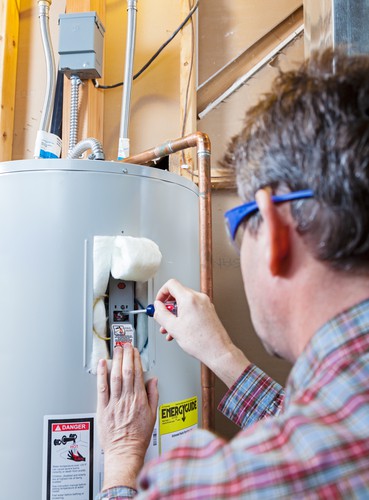
Water heater leaking? You’ll want to deal with it right away, so it doesn’t turn into a major problem. Even a small amount of water can cause damage to floors and walls. In extreme cases, a complete water heater malfunction can result in a significant flood, leading to damaged personal property and hefty repair bills. Water heater leaking can also lead to health problems. Wet and damp areas can generate mold and mildew growth that can cause asthma and allergic reactions.
Hot Water Heater Leaking? Why?
A Leaking Drain Valve
The drain valve, located at the bottom of the tank, is used to get rid of sediment build-up that can cause damage to the tank. If the drain valve is defective, water will start to leak, pooling at the bottom of the tank. Also, if the drain valve is no longer water-tight, water can start to seep out along the edges of the valve.
Leaking Temperature and Pressure Relief Valve
This valve is specifically designed to release water if the water gets too hot or there’s excessive pressure inside the tank. The temperature and pressure relief valve is built with a discharge tube that extends from the valve to the floor. The tube’s purpose is to safely direct any water that leaks from the valve down, towards the floor, instead of in an outward direction where it could cause harmful problems.
The Tank’s Leaking
If the tank itself is leaking, there’s an internal problem, typically brought on when one of the components has started to leak slowly, causing water to pool at the bottom of the tank. Ordinarily, the cause of this problem is sediment build-up in the tank. If the sediment remains in the tank long enough, it will start to rust and crack the tank, ultimately causing a leak. If the tank’s leaking, the water heater will more than likely need to be replaced.
Fast Ways to Get it to Stop
If you’ve noticed a water heater leaking problem, the fastest way to get it to stop is to turn off the water to your tank. The tank has a shutoff valve, located on the cold inlet pipes. If the shutoff valve has a wheel that turns, referred to as a gate style valve, turn it clockwise until it’s firmly off. If it’s a ball style valve, the handle needs to be turned 180 degrees.
If you find that the shutoff valve is broken, use your home’s main water shut off valve which will stop the flow of water to your entire home. Next, you’ll need to turn off the power supply. Gas water heaters have a gas shut off valve that’s located on the gas line that leads to the tank. If you have an electric water heater, you can turn the power off at the breaker.
Is your water heater leaking? We can help. Contact us today.
Write a comment: